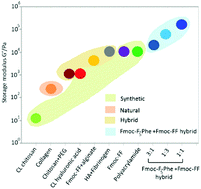Molecular co-assembly as a strategy for synergistic improvement of the mechanical properties of hydrogels†
Abstract
Molecular self-assembly is a key direction for the fabrication of advanced materials. Yet, the physical properties of the formed assemblies are limited by the inherent characteristics of the specific building blocks. Here, we have applied a co-assembly approach to synergistically modulate the mechanical properties of peptide hydrogels, thereby forming extremely stable and rigid hydrogels.



 Please wait while we load your content...
Please wait while we load your content...